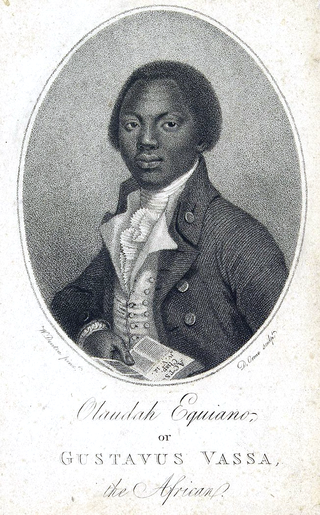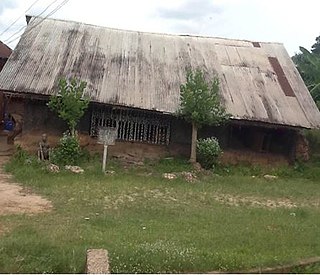
The Igbo people are an ethnic group in Nigeria. They are primarily found in Abia, Anambra, Ebonyi, Enugu, and Imo States. A sizable Igbo population is also found in Delta and Rivers States. Ethnic Igbo populations are found in Cameroon, Gabon, and Equatorial Guinea, as migrants as well as outside Africa. There has been much speculation about the origins of the Igbo people, which are largely unknown. Geographically, the Igbo homeland is divided into two unequal sections by the Niger River—an eastern and a western section. The Igbo people are one of the largest ethnic groups in Africa.

The Bight of Biafra is a bight off the west-central African coast, in the easternmost part of the Gulf of Guinea.

Olaudah Equiano, known for most of his life as Gustavus Vassa, was a writer and abolitionist. According to his memoir, he was from the village of Essaka in modern southern Nigeria. Enslaved as a child in Africa, he was shipped to the Caribbean and sold to a Royal Navy officer. He was sold twice more before purchasing his freedom in 1766.

The Zong massacre was a mass killing of more than 130 enslaved African people by the crew of the British slave ship Zong on and in the days following 29 November 1781. The William Gregson slave-trading syndicate, based in Liverpool, owned the ship as part of the Atlantic slave trade. As was common business practice, they had taken out insurance on the lives of the enslaved Africans as cargo. According to the crew, when the ship ran low on drinking water following navigational mistakes, the crew threw enslaved Africans overboard.
Afro-Trinidadians and Tobagonians are people from Trinidad and Tobago who are of Sub-Saharan African descent, mostly from West Africa. Social interpretations of race in Trinidad and Tobago are often used to dictate who is of West African descent. Mulatto-Creole, Dougla, Blasian, Zambo, Maroon, Pardo, Quadroon, Octoroon or Hexadecaroon (Quintroon) were all racial terms used to measure the amount of West African ancestry someone possessed in Trinidad and Tobago and throughout North American, Latin American and Caribbean history.

Igboland, also known as Southeastern Nigeria, is the indigenous homeland of the Igbo people. It is a cultural and common linguistic region in southern Nigeria. Geographically, it is divided into two sections by the lower Niger River: an eastern and a western one. Its population is characterised by the diverse Igbo culture and the speakers of equally diverse Igbo languages.

The Interesting Narrative of the Life of Olaudah Equiano, Or Gustavus Vassa, The African, first published in 1789 in London, is the autobiography of Olaudah Equiano. The narrative is argued to represent a variety of styles, such as a slavery narrative, travel narrative, and spiritual narrative. The book describes Equiano's time spent in enslavement, and documents his attempts at becoming an independent man through his study of the Bible, and his eventual success in gaining his own freedom and in business thereafter.
Alexander Falconbridge was a British surgeon who took part in four voyages in slave ships between 1782 and 1787. In time he became an abolitionist and in 1788 published An Account of the Slave Trade on the Coast of Africa. In 1791 he was sent by the Anti-Slavery Society to Granville Town, Sierra Leone, a community of freed slaves, where he died a year later in 1792.
Oyinbo is an early Yoruba word used to refer to Caucasians. In the 1470s, the first Portuguese birth occurred in Eko, in Yorubaland, later called Lagos. The word was first used by the Yoruba to describe the Portuguese. It would later extend to all Europeans. Many years later, the word became used for anyone influenced by European tradition, customs, and culture, especially once-enslaved returnees. Oyinbo is generally used to refer to a person of European descent, Africans perceived to be not culturally Yoruba, or to people of any race considered light-skinned. The word is generally understood by most Nigerians and many other Africans.

Catherine Obianuju Acholonu was a Nigerian author, researcher and political activist. She served as the Senior Special Adviser (SSA) to President Olusegun Obasanjo on Arts and Culture and was a founder-member of the Association of Nigerian Authors (ANA).
Afro-Jamaicans are Jamaicans of predominant Sub-Saharan African descent. They represent the largest ethnic group in the country. Most Jamaicans of mixed-race descent self-report as just Jamaican.

Igbo Americans, or Americans of Igbo ancestry, are residents of the United States who identify as having Igbo ancestry from modern day Nigeria. There are primarily two classes of people with Igbo ancestry in the United States, those whose ancestors were taken from Igboland as a result of the transatlantic slave trade before the 20th century and those who immigrated from the 20th century onwards partly as a result of the Nigerian Civil War in the late 1960s and economic instability in Nigeria. Igbo people prior to the American Civil War were brought to the United States by force from their hinterland homes on the Bight of Biafra and shipped by Europeans to North America between the 17th and 19th centuries.
Igbo people in Jamaica were trafficked by Europeans onto the island between the 18th and 19th centuries as enslaved labour on plantations. Igbo people constituted a large portion of the African population enslaved people in Jamaica. Jamaica received the largest amount of enslaved people from the biafra region than anywhere else in the diaspora during the slave trade. Some slave censuses detailed the large number of enslaved Igbo people on various plantations throughout the island on different dates throughout the 18th century. Their presence was a large part in forming Jamaican culture, Igbo cultural influence remains in language, dance, music, folklore, cuisine, religion and mannerisms. In Jamaica the Igbo were often referred to as Eboe or Ibo. There are a substantial number of Igbo language loanwords in Jamaican Patois. Igbo people mostly populated the northwestern section of the island.

The Sons of Africa were a late-18th-century group in Britain that campaigned to end African chattel slavery. The "corresponding society" has been called the Britain's first black political organisation. Its members were educated Africans in London, including formerly enslaved men such as Ottobah Cugoano, Olaudah Equiano and other leading members of London's black community.

A scramble was a particular form of slave auction that took place during the Atlantic slave trade in the European colonies of the West Indies and the domestic slave trade of the United States. It was called a "scramble" because buyers would run around in an open space all at once to gather as many enslaved people as possible. Another name for a scramble auction is "Grab and go" slave auctions. Slave ship captains would go to great lengths to prepare their captives and set prices for these auctions to make sure they would receive the highest amount of profits possible because it usually did not involve earlier negotiations or bidding.
For a history of Afro-Caribbean people in the UK, see British African Caribbean community.

Black Barbadians or Afro-Barbadians are Barbadians of entirely or predominantly African descent.

Igbo Landing is a historic site at Dunbar Creek on St. Simons Island, Glynn County, Georgia. It was the setting of a mass suicide in 1803 by captive Igbo people who had taken control of their slave ship and refused to submit to slavery in the United States. The event's moral value as a story of resistance towards slavery has symbolic importance in African American folklore as the flying Africans legend, and in literary history.

The Okoroji House Museum or Okoroji House,, is a historic house and museum located in Ujari, a village in Arochukwu, Abia State, Eastern Nigeria. The house was declared a national monument in 1972 by the National Commission for Museums and Monuments.

George Case (1747–1836) was a British slave trader who was responsible for at least 109 slave voyages. Case was the co-owner of the slave ship Zong, whose crew perpetrated the Zong massacre. After the massacre, the ship owners went to court in an attempt to secure an insurance payout of £30 for each enslaved person murdered. A public outcry ensued and strengthened the abolition movement in the United Kingdom. In 1781, he became Mayor of Liverpool. After he died, the wealth generated by his slavery was bequeathed to the Case Fund by his grandson.















